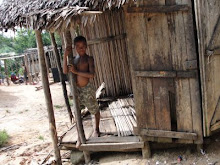Thank goodness I’m residing in a populated area and have access to potent chemical solutions to end this problem. Not. Fortunately I have parents who think ahead and sent a care package of bug bombs and doggie flea collars (no, that’s not a joke, I will put them on my pant legs…I guess our military currently does this in the Middle East to battle flea issues) when they heard there might be a flea problem. Now, I just have to sit and patiently wait for this package to arrive and then I’m going to go ape on these fleas. I don’t care if the headquarter offices are below the residential floors…I’m blowing these little jerks from here to kingdom come with these bug bombs.
So there you have it, that’s my strategery once my arms shipment arrives.
In other random news, I went for a nice little Saturday stroll down to the market just to check things out and almost got run over by a cow. No, not a bull. A cow. You really have to be NOT paying attention to what you’re doing to have a near collision with a cow…the only animal that might, quite possibly, be slower than a cow is a turtle. I don’t know why, but a herd of cattle being bustled down the street wasn’t really on the forefront of my mind that afternoon. Fortunately my sixth sense of impending doom and catlike reflexes saved me from the dire situation. No really, I just looked up…slowly stepped to my right…and let the cow continue to jog down the hill. Sorry, very anti-climactic. Although judging by the reaction of the locals to the situation they sure seemed to think they were going to see a game of cow vs. “vazaha” (foreigner or white person – kids point at me and say that all the time, lol) “smear the queer.”
Alas, I didn’t even make it to the market that afternoon. After what we will heretofore refer to as “The Cow Incident,” I was stopped by a local elderly gentleman who wanted to talk to me in English…gee, I wonder what gave it away that I might speak English? Anyway, I couldn’t understand much because of his heavy accent and the fact that he didn’t know much English (although he knows much more English than I know French or Malagasy!). However, I was able to figure out that he wanted me to give him an English Bible. Of course, I am a foreigner who sticks out like a sore thumb around here, naturally, I have Bibles, lol. Actually, I do, well, I did. After I went back to headquarters and gave him my Bible, he invited me to have dinner with his family in a town about 20 km away. I politely declined because obviously it wouldn’t be too wise to travel by myself to a stranger’s house that was far away, but he said he was coming back to town next month and would like to practice more English. I told him when he’s in town next month to swing by the headquarters and have the security guard come get me. If I’m there, I’d be more than happy to have another little impromptu English practice session in front of the HQ. Hopefully Gil, Ben, or Sarah will be around to help translate so I can understand more what he says. We’ll see if he shows up.
Last random sidenote: today a pushcart rolled up at our headquarters and disposed of a dead body in a coffin, covered with a sheet. The coffin was just chillin there by the side of the road…I guess waiting to be picked up and taken to its final destination. Every time I’d look out the window this afternoon…“oh yeah, there’s a coffin.” Definitely no shortage of randomness in Madagascar. Love it!

Yo! You forgot something!





























